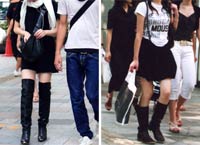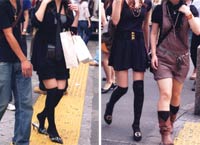|
|
|||||||
|
|
|||||||
|
|||||||
| | Web Japan >> | Trends in Japan >> | Fashion >> | Monotones for Fall | |
|
MONOTONES FOR FALL A Refreshing Breath of Chic After a Casual Spell (October 5, 2006) As fall deepens, young women's fashions are turning black and white. The key is a touch of chic: for instance, a white shirt coordinated with a black vest, a black pleated skirt, and black and white half boots. Popular among Harajuku girls, meanwhile, are avant garde gosurori (Gothic Lolita) and punk styles, and their street hangouts seem almost dyed through in blackish hues. Female office workers and career women in Ginza are likewise dressing in elegant combinations like white blouses and black cardigans with pants. One notable characteristic of the trend is that mature fashions are being favored by a broad range of people, with young men and middle-aged women going for monotone looks as well. Monotone As a Resetter
A 10-Year Cycle Typically, a monotone wave follows a few years on the heels of a fad for layered, decorative, or colorful styles, such as the layered fashions with denims in the late 1970s, the colorful bodikon (body-conscious) dresses of the 1980s, the vivid colors donned by teenagers in the mid-1990s, and the fluorescents that emerged around 2003. This fall the teenage girls filling the streets of Shibuya, who until recently worshipped colorful fashions, are all fading to blacks, whites, and grays. Along with monotones, a trend for mature, sparsely ornamented, conservative styles looks ready to set in. Copyright (c) 2006 Web Japan. Edited by Japan Echo Inc. based on domestic Japanese news sources. Articles presented here are offered for reference purposes and do not necessarily represent the policy or views of the Japanese Government. |
||||||||
|
||||||||




